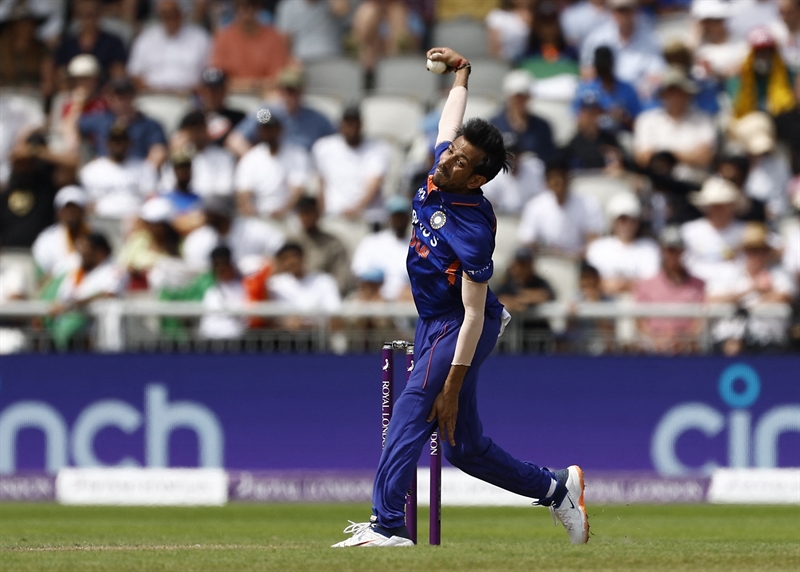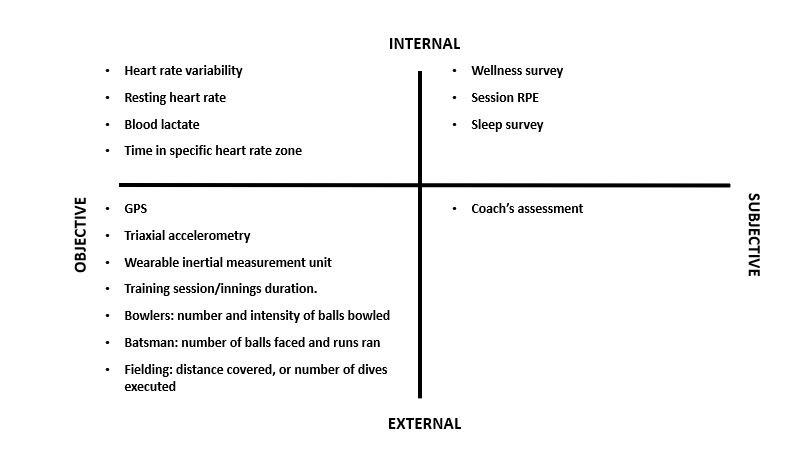You are viewing 1 of your 1 free articles
Exercise monitoring for a stellar innings

Practitioners define workload as “the amount of stress placed on an individual in response to exercise over a period of time”(1). Although there is ambiguity in what the term represents, load monitoring may maximize positive training process outcomes, such as improved performance and fitness, while reducing non-functional overreaching, fatigue, and risk for musculoskeletal injuries or illnesses(1–3). An understanding of loading and unloading affects the mechanobiology and capacity of musculoskeletal structures. Therefore, it is essential for the conditioning and rehabilitation of athletes(4). Cricketers, especially fast bowlers, are at risk of over- and underloading, which increases the injury risk(1,5–7).
Most workload research is on fast bowlers, with the debate surrounding optimal workloads. However, regardless of a player’s position in a team, cricket requires a combination of running, throwing, diving, and batting(1). Therefore, clinicians need to identify appropriate measures to assess the demands and interactions of each activity to depict the overall physical and psychophysiological impact.
Workload vs. Exercise monitoring
The term “workload,” in the context of sports medicine and exercise science, has received some scrutiny(8). The term describes the intensity and volume of athletes’ activities during training and match play(2). In this context, however, neither “work” nor “load” refers to the terms’ original scientific properties, nor are they expressed in their respective SI-Units, i.e., “joule” and “watt”(8). Appropriately using definitions and the SI is important as it enables a uniform understanding and forms the scientific basis. During the reporting of exercise and training, practitioners and researchers should correctly use scientific terms and units(8). The American College of Sports Medicine (ACSM) suggests using frequency, intensity, time, type, volume, and progression (P; FITT-VP) for exercise monitoring and prescription. Exercise volume includes exercise intensity, time, and frequency.Exercise monitoring constructs and methods
Measurable constructs related to exercise monitoring include internal and external training or match-related stressors(1,8). Practitioners classify a player’s total mechanical and locomotive stress as external. Internal stressors include the physiological and psychological stress imposed on players in response to external factors(1,8).Irrespective of the sport, the literature is divided in terms of which monitoring methods to use, when to implement them, and how to analyze the data. Nevertheless, researchers investigating the relationship between internal and external measures have found that, compared to other internal measurements, the session rate of perceived exertion (RPE) is a valid method of exercise monitoring amongst cricket batsmen and medium-fast bowlers(9). The RPE, using Borg’s Category Ratio 10 [CR-10] scale, is calculated by multiplying an individual’s reported RPE by the duration of a training session (in minutes)(1,2).
Considering the high technical load specific to cricket and the various playing positions, the use of external measures based on the technical demands of the player position is one way to approach cricket-specific exercise monitoring. These external measures include (global positioning system) GPS and wearable inertial measurement unit (IMU). External measures derive data such as body load, number of impacts, and distance covered per match or skills training session(2,9). Furthermore, practitioners can select a variety of objective and subjective measurements of internal and external stressors (see figure 1).
Figure 1: Methods of objective and subjective measurement of internal and external stressors among cricketers

Position-specific exercise monitoring
The greatest challenge about cricket is that it consists of four distinct disciplines requiring specialized skills. These include batting, bowling, fielding, and wicket keeping. These different roles are unique, with their own physiological and biomechanical demands. Therefore, practitioners need to consider the evident differences in position-specific RPE responses. In high-performance environments, it is common to prescribe individualized player training programs specific to their respective match demands(9). Compared to other players, fast bowlers endure greater physical demands and are subject to greater external stressors(9,10). Irrespective of match format, fast bowlers cover 20–80% greater distances, exert two to seven times higher intensity in running speeds, and have 35% less recovery time between high-intensity efforts(9,10). Additionally, fast bowlers are at more significant risk of sustaining injuries, missing approximately 16% of potential playing time, whereas the prevalence rate for all other positions is less than 5%(11).Several national organizations limit the number of deliveries a medium-fast bowler can perform in training. The number of medium-fast bowlers, therefore, typically limits the net-based training session dose. As a result, the coaching staff is more likely to develop training programs based on this measure than internal heart rate-based or external GPS-derived measures.
Bowling volume is usually self-reported by players. There are suggestions that injury risk thresholds for bowlers are between 123-188 deliveries per week. More than three and a half days between sessions and greater than 50 deliveries per day can also lead to injury(1). However, there is a disparity regarding the reliability of players’ self-reported data(12). Cricket and other throwing dominant sports would benefit from developing an automated monitoring tool to assess bowling and throwing volume objectively.
While data related to the number of deliveries is important, it is vital not to neglect intensity-related data. When structuring pace bowlers’ training programs, it is essential to establish the goal for each session while keeping the number of balls, intensity, i.e., the run-up length and speed, and bowling speed, in mind (see box).
Weekly bowling sessions for pace bowlers with different goals and varying intensity.
Session 1: Max effort speed day where the direction is not a focus.
Session 2: Directional focus but with intent and knowledge of results.
Session 3: Loaded resisted power-driven day using a weighted ball.
______________________________________________________
During matches, spin bowlers do not cover as much distance because of run-up length differences and the higher fine motor skill demands than fast bowlers who use more gross motor skills(1). Therefore, most bowling volume distribution would lean toward directional and intent focussed sessions.
During the limited overs format, batters cover, on average, the least amount of distance (1.4-1.7km) compared to the other disciplines. For example, a hypothetical century scored by a batter will require them to cover an average distance of 3.2km. Notably, they will spend approximately 63% of the time above 75% of their maximum heart rate(1). In addition to batting volume, practitioners can use GPS and heart rate data to monitor running volume and structure training sessions.
With the introduction of the T20 format, fielders’ margin for error is significantly smaller than it used to be. Nowadays, fielders need to cover more distance at faster speeds to limit the number of runs conceded by the bowlers(1). Fielders cover, on average, between 5.4-6.0 km during T20 and one-day matches. The duration of matches does not affect the fielding distance covered as much as the intensity, as players must do more work over a shorter period. The intensity of T20 is almost double that of other formats(1). In preparation for a series of matches, training volume thresholds and monitoring should reflect the match format fielding demands.
Models for analyzing exercise volume
The acute: chronic workload ratio (ACWR) is a model commonly used in cricket to provide an index of athlete preparedness. The ideal training stimulus, i.e., the ‘sweet spot,’ maximizes net performance potential by having an appropriate training load while limiting the negative consequences of overtraining, including injury, illness, and fatigue(2). For example, in bowling volume, the ideal reported ACWR among cricket pace bowlers is between 0.8 and 1.3(2). Practitioners can use three common methods to analyze and quantify training-load data (table 1).Table 1: Models for analyzing cricketers’ exercise volume(2).
| Model | Description |
|---|---|
| Fitness-Fatigue Model | Performance tends to reduce immediately after a workout (up to a few days). However, after the initial reduction, there is a rebound, and performance improves. |
| Acute:Chronic Workload Ratio model (ACWR) | A ratio comparing recent training loads (5-10 days) to chronic training loads completed over a lengthy period (usually 4-6 weeks). |
| Internal:External-Load Ratio | Measures the ratio between the athletes psychophysiological stress and the external training load. A higher ratio suggests athlete weariness or decreased fitness. A lower ratio indicates that the athlete is developing fitness and dealing with the training. |
Conclusion
Training programs are traditionally prescribed based on external measures. However, recent evidence suggests combining internal and external measures may be the most appropriate method to holistically quantify players’ exercise volume. Additionally, using more than one workload-monitoring technique provides coaches with an understanding of the factors influencing performance and contributing to injury. Thereby facilitating further individualization of the training process.References
- Indian J Orthop. 2020;54(3):271-274.
- Int J Sports Physiol Perform. 2017;12(s2):S2-161-S2-170.
- Br J Sports Med. 2014;48(8):708-712.
- Br J Sports Med. 2015;49(23):1484-1485.
- Br J Sports Med. 2002;36(4):270-274.
- J Sci Med Sport. 2003;6(3):359-367.
- Sports Med. 2017;47(3):503-515.
- J Sci Med Sport. 2022;25(5):439-444.
- Int J Sports Sci Coach. 2018;13(2):290-301.
- J Sports Sci. 2010;28(1):45-52.
- J Sci Med Sport. 2006;9(6):459-467.
- Sports Med. 2016;46(10):1503-1516.
Related Files
Newsletter Sign Up
Subscriber Testimonials
Dr. Alexandra Fandetti-Robin, Back & Body Chiropractic
Elspeth Cowell MSCh DpodM SRCh HCPC reg
William Hunter, Nuffield Health
Newsletter Sign Up
Coaches Testimonials
Dr. Alexandra Fandetti-Robin, Back & Body Chiropractic
Elspeth Cowell MSCh DpodM SRCh HCPC reg
William Hunter, Nuffield Health
Be at the leading edge of sports injury management
Our international team of qualified experts (see above) spend hours poring over scores of technical journals and medical papers that even the most interested professionals don't have time to read.
For 17 years, we've helped hard-working physiotherapists and sports professionals like you, overwhelmed by the vast amount of new research, bring science to their treatment. Sports Injury Bulletin is the ideal resource for practitioners too busy to cull through all the monthly journals to find meaningful and applicable studies.
*includes 3 coaching manuals
Get Inspired
All the latest techniques and approaches
Sports Injury Bulletin brings together a worldwide panel of experts – including physiotherapists, doctors, researchers and sports scientists. Together we deliver everything you need to help your clients avoid – or recover as quickly as possible from – injuries.
We strip away the scientific jargon and deliver you easy-to-follow training exercises, nutrition tips, psychological strategies and recovery programmes and exercises in plain English.










